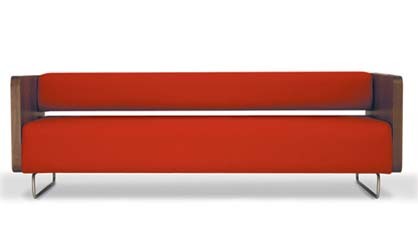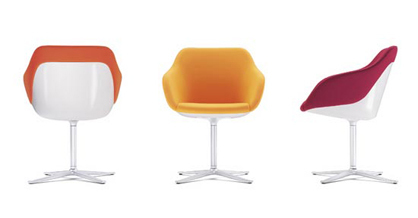The logical thought to create useful things
Texto por Nora Schmidt
Berlin, Alemania
05.01.08
For more than ten years the very successful design studio of Luke Pearson and Tom Lloyd has been located in one of Shoreditch's typical small alleys.
Shoreditch used to be a typical working class quarter in the North-East of London until the end of the 19th century, when its textile and furniture industries declined. By the end of the 19th century Shoreditch was a neighbourhood known for crime and prostitution. Today, after many artists and designers moved to Shoreditch in the 80ies, it is one of London's hippest quarters.
For more than ten years the design studio of Luke Pearson and Tom Lloyd has been located in one of Shoreditch's typical small alleys. Today PearsonLloyd Design is one of the most successful design companies in Britain.
Tom Lloyd and Luke Pearson behind Link, a modular system designed for Arpro, 2007
How did you get to know each other?
Luke Pearson: When we were working for different people, we kind of had the same dream. The studio is slightly different to other design studios. We both studied furniture as well as product design. Most of the other designers are either one or the other, but we do both. We have a different approach to product and furniture design.
I studied furniture design after studying product design, because I thought product design often lacked a cultural approach.
Could you please explain this difference?
LP: Products tend to be more global than furniture. They want to sell that MP3-player everywhere. On the other hand you don't know whether apple made this laptop case, because of its inside shape or whether they simply liked the soft forms and colours. But with furniture design you know that it has its particular shape for a reason. Furniture design is quiet different, because it's quiet regional.
And what about you Tom?
Tom Lloyd: I switched the other way around. I went to do product design after furniture design. Product design's biggest influence is technological innovation.
But isn't this also true for furniture design?
LP: Of course, on the whole, the most famous pieces of furniture generally derived through technological breakthroughs. Look at Jacobsen's 3107 series or Eames' aluminium group.
It seems, that you developed your own unique style. Are you trying to develop a recognisable style?
TL: That's interesting.
LP: I think, we would hate to think that we were developing consciously a style. In fact, we would really hate that. We don't want to make fashion. If it became fashionable, that would be fine. But that is not our ambition. To us every single project is attached with a completely fresh set of parameters.
TL: But there are certain trends we are conscious of. We don't start from scratch.
LP: Of course, we are very much into the idea of things being timeless. We like to think that our work is the result of the logical thought to create useful things. And that is why it is very dangerous to devote your design to fashion trends.
But isn't fashion a part of our culture?
LP: Of course, but you have to make sure, that the trend you get hold of, is there for a good reason.
You are also part of the jury at the Audi Design Foundation. What is that all about?
LP: The competition is called Design of Substance. They set up this competition - basically to produce products for underprivileged areas in the world. It is giving students a very balanced view of how design can actually be a beneficial good.
Should Design be political?
LP: I think by definition it is. And it is going to be more so. Environmental concerns become more of an issue. They sold 1 million iphones after a month. ONE MILLION of one item! I can't even imagine what one million of anything looks like. If you are a designer of a product, that is going to be sold in large numbers, you have to consider the environmental aspects, no matter whether it is a luxury product like the iphone or a regular plastic bottle you are designing.
You are also teaching at design schools. How did design schools change, compared to when you were studying?
TL: There are more students. The design schools produce 100 students a year these days, which is absurd. I wonder, how they are supposed to have enough training. Actually the students come out with fewer and fewer skills. To design means to have a certain idea and the ability to bring it in production. It does not mean building up dreams.
PL: When I went to the Central St. Martins, there were 18 students. By that time we had maybe four good and two very good students. If I go and look around at design schools nowadays, they have 100 students and I see only four good ones and maybe two very good ones.
Obviously studying design is a popular choice.
TL: That has to do with the increasing media attention. It became an incredible trendy thing to do. But it takes more to be a good designer, than just college education. The natural talent plays a major role.
LP: But of course there is also increasing demand for designers. With the development of new technologies, we throw new products on the markets very, very quickly and the production process costs less. At the end you have more designers, designing more products in a shorter time frame; also these products are very short-lived.
Your company grew a lot since you founded it. How did this influence your work?
TL: We try to stay the designers of our products. Designing furniture is a very personal process. And also it has a lot to do with the dialogue with our clients. These dialogues, you can hardly hand over to other people. If you look at other large design studios, you will get to see just how much the work of the founders changed. You suddenly find yourself managing the business more than you are part of the design process. We don't want that.
LP: Of course, we are not doing CAD-work anymore. There were times, when we had ten people working in our studios. We have to rely on somebody understanding us and our concepts. Besides that, we love this dialogue. This is partly the reason, why we started a partnership. Design is always a collaborative process. No designer ever did anything totally on his own. There is always an engineer or maybe an enlightening conversation with a client behind it.
Talking to you, I get the impression, that a vital exchange of ideas with your customers is very important to you.
LP: Yes, we had a very nice experience with Allermuir, a British manufacturer, which was recently bought by Senator. They grew a lot in the last years and I think they could be one of the big European players in the next ten years, which is great, because they are very open to new stuff. They like to try things out. We generally don't believe in ourselves in Britain. The British are the best people in the world, when it comes to talking down the British. We love losing. When we founded our business, journalists asked us, what makes you think, you could make it? And we asked them back, what should make us think, we wouldn't?
Thanks for this interview.







